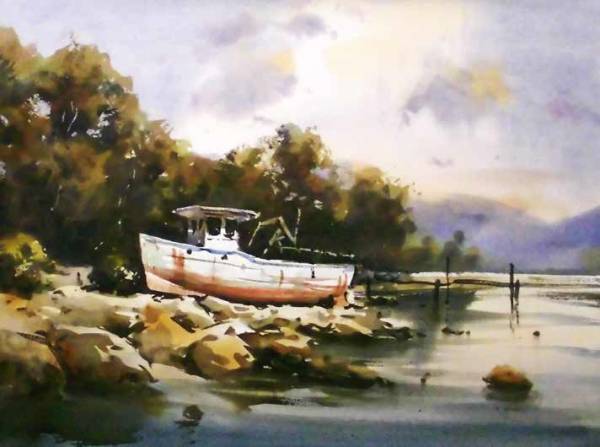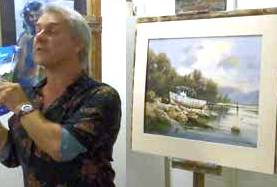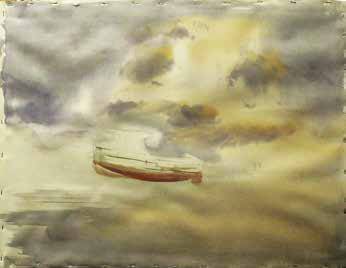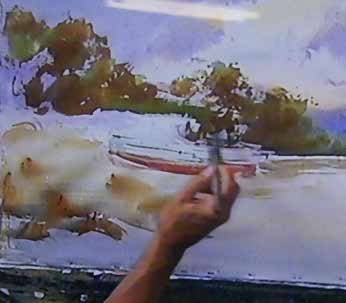Saturday 17th February at 2.00pm, Greg
Allen
Watercolour Demonstration

 The full house for Greg Allen’s demo was given a full serve of
entertainment and instruction. Greg is a captivating personality. He
loves teaching and does it with energy and enthusiasm. He is extremely
generous with his time and expertise. He is an activist for watercolour
in the battle against oils, acrylics and pastel. However he does
acknowledge the frustrations of watercolour. So many swear words are
uttered over cauliflowers, fading colours, overworked areas, insipid
results. It is not easy to predict how a watercolour will dry, and you
have to get it right first time, whereas with the opaque mediums
what you see is what you get. With watercolour, going over it to
correct something, you lose freshness.
The full house for Greg Allen’s demo was given a full serve of
entertainment and instruction. Greg is a captivating personality. He
loves teaching and does it with energy and enthusiasm. He is extremely
generous with his time and expertise. He is an activist for watercolour
in the battle against oils, acrylics and pastel. However he does
acknowledge the frustrations of watercolour. So many swear words are
uttered over cauliflowers, fading colours, overworked areas, insipid
results. It is not easy to predict how a watercolour will dry, and you
have to get it right first time, whereas with the opaque mediums
what you see is what you get. With watercolour, going over it to
correct something, you lose freshness.
To attack the problem of colours drying lighter than you expect he had a plan. Take no notice of the strength of the colour as it looks on a white palette. Always have a spare bit of w/c paper and make a mark with a loaded brush and draw it out. That is more like the resultant colour you will get than it looks on white enamel. To get strong darks use a creamy or treacle consistency of paint. To avoid cauliflowers paint thick over thin, not thin over thick. If painting from a reference hold your colour against that of the picture and compare. It may be that the colour of the real world is greyer than you think. He had a very dirty palette and did not apologise for it. You get some useful greys from a dirty palette.
There is so much knowledge in that head and it spills out. He is quite scientific in explaining things, such as reflections on water, shadows on sides versus highlights on tops. Ideas like that came into his demo of a scene in which a beached boat is resting on rocks at the edge of a body of water.
It was to be a full sheet, vertical on the easel. This setup posed many problems, and he seemed a bit reticent to start. No wonder. He had done a light pencil sketch. This brought out a lesson on drawing. Boats, it seemed. But really it was about measuring. Find a unit of length, eg. the width of the back of the boat. With a straight arm mark it with your thumb on your brush handle. Now go to the length of the boat. How many units are there in that length? If you measure everything in that way your drawing will be in proportion. He talked about the science of mirrors and reflections. To practise your skills you should place a 3D object on a mirror and draw it with its reflection from several angles. Good idea. Do it.
 He began the painting
by wetting the paper, seemingly all over, but in fact leaving the boat
dry, as he wanted a hard edge on that. Then a very loose sky wash,
vigorously with a big brush. Soon some dark clouds with soft edges.
Big gaseous masses with daggy edges the way they are if you look at
them. The boat is manmade so it has hard edges. To achieve this he
mixed dark grey greens for a mass of trees in the background and cut
around the boat making it pop out.
He began the painting
by wetting the paper, seemingly all over, but in fact leaving the boat
dry, as he wanted a hard edge on that. Then a very loose sky wash,
vigorously with a big brush. Soon some dark clouds with soft edges.
Big gaseous masses with daggy edges the way they are if you look at
them. The boat is manmade so it has hard edges. To achieve this he
mixed dark grey greens for a mass of trees in the background and cut
around the boat making it pop out.
A break for afternoon tea gave it a bit of drying time.
 Mountains, trees, boat and a hint of rocks were
done. Then came another lesson. The world is composed of basic
shapes, cylinder, cone, block, ball, and they are shaded according to
the light source. All right, let us put these rocks in. Rocks behind
rocks. Details of the boat.
Mountains, trees, boat and a hint of rocks were
done. Then came another lesson. The world is composed of basic
shapes, cylinder, cone, block, ball, and they are shaded according to
the light source. All right, let us put these rocks in. Rocks behind
rocks. Details of the boat.
Know about what you are painting to get authentic detail. He had hints about painting rocks and sticks in water with their reflections. It all came together, especially when he put a mount around it. Remarkable. And he loved doing it. “The best fun you can have with your clothes on,” he said. Thanks Greg. Great demo.
Report by Colin Browne
Copyright
© 2018
Whitehorse Art Society
All rights reserved.